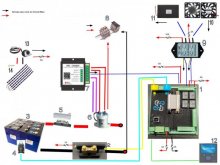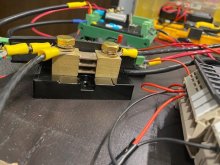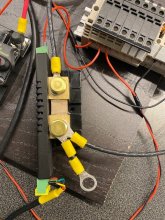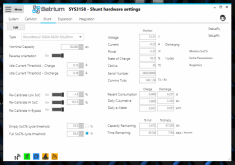Hello everyone,
I have a 2000 Monaco MotorHome, I will be installing eight 272ah Lishen LiFePo4 cells making a 2p4s 12v 500Ah (useable) battery. My two largest loads are a Victron MultiPlus 12/3000 inverter/charger and the engine "Boost" if my chassis battery gets low. For the BMS I chose a Batrium Watchmon with four Blockmons (cell monitors) and the expansion board.
The main reasons for this BMS are its ability to connect to my Victron CCGX on the CAN-Bus. This will pass bms info to the CCGX. Also I will have a 400 amps of power available. (The size of my Class T Fuse). It will control Fans (to help cool things) and a Heater (for under the battery). I also liked how the software was easy to understand and change. This BMS checked all my "Must Have" boxes and many of my "Like to Have" boxes. The biggest downside is it is an expensive BMS's - especially when adding all the other parts.

Here are my plans for the stuff attached to the BMS.
I have finally received everything except the batteries - they are on a slow boat from China... a very slow boat...
I also decided to make a small portable 12v 50ah lithium battery. I decided on a Harbor Freight "Pelican" case -Apache 2800. For the batteries, I am using eight 25ah Fortune cells in a 2p4s 12v 50ah battery. I picked up those batteries (local to me) at Electric Car Parts Company. I will be putting an Overkill BMS on this battery. I really like these Fortune batteries, I got to see the 60ah & 100ah when I was picking them up. They are very nice!
I figured since I had cells, I would startup the Batrium BMS and start "Playing" around with it. So I put the 25ah cells into supercells, and created the 12v battery. I attached them together with VHB tape. These cells were all at the exact same voltage 3.329v for shipping. I decided rather that doing a traditional top-balance, I would let the Batrium Top balance the cells.
So I have added the Blockmons to the cells and started wiring it up. Have the Shunt and the 30a breaker installed - Yes it is a bit of a mess!

And I am slowly charging it. I feel comfortable letting the Blockmons do the Top balance because they can balance 28.8ah per day. (That's half the size the this battery...).
Well - that's about all for tonight. I will update as I work on the project.
I have a 2000 Monaco MotorHome, I will be installing eight 272ah Lishen LiFePo4 cells making a 2p4s 12v 500Ah (useable) battery. My two largest loads are a Victron MultiPlus 12/3000 inverter/charger and the engine "Boost" if my chassis battery gets low. For the BMS I chose a Batrium Watchmon with four Blockmons (cell monitors) and the expansion board.
The main reasons for this BMS are its ability to connect to my Victron CCGX on the CAN-Bus. This will pass bms info to the CCGX. Also I will have a 400 amps of power available. (The size of my Class T Fuse). It will control Fans (to help cool things) and a Heater (for under the battery). I also liked how the software was easy to understand and change. This BMS checked all my "Must Have" boxes and many of my "Like to Have" boxes. The biggest downside is it is an expensive BMS's - especially when adding all the other parts.

| Supplier | |||
| 1 | Batrium BMS | Batrium | Power 12v 3A Fuse on Pos & Neg - Relays 12v@5A |
| 2 | Shunt | Batrium | Power 1A Fuse Positive - Shunt wire to BMS |
| 3 | Batteries | Lishen | Eight 272Ah Cells 2P4S 544Ah @ 13v (w/4 Blockmon8's on cells) |
| 4 | Blockmon8 | Batrium | Blockmon8 Qty 4 - one on each SuperCell |
| 5 | 400A Class T Fuse | Blue Sea 5502 | Class T Fuse Holder + Fuse +(1 backup fuse) |
| 6 | Contactor 500A | Kilovac EV200AAANA500 | Kilovac EV200AAANA500 Amp Contractor Relay - Max Inrush 3.7A - Holding 1.7W) |
| 7 | Pre-Charge | REC-BMS | Pre Charge Controller 5A Fuse |
| 8 | Terminal Blocks w/ Fuse | Fuse Box w/ Neg. 6 Fuses | |
| 9 | 2 Relays 10A | CZH-Labs | Fuses (BMS Side) 5A combined |
| 10 | Fans (2) | Amazon | Fuses 5A |
| 11 | Heating Pad 12"x 18" | Amazon-Facon CW-T12218 | 65 watts (Fuse 10A) |
| 12 | Victron CCGX | Victron CCGX | Need Can-Bus Wire ran between BMS & CCGX |
| 13 | Switch | Amazon | Fuse 5A |
| 14 | LED Lights | Amazon | 12" Lights Qty 3 or 4 |
Here are my plans for the stuff attached to the BMS.
I have finally received everything except the batteries - they are on a slow boat from China... a very slow boat...
I also decided to make a small portable 12v 50ah lithium battery. I decided on a Harbor Freight "Pelican" case -Apache 2800. For the batteries, I am using eight 25ah Fortune cells in a 2p4s 12v 50ah battery. I picked up those batteries (local to me) at Electric Car Parts Company. I will be putting an Overkill BMS on this battery. I really like these Fortune batteries, I got to see the 60ah & 100ah when I was picking them up. They are very nice!
I figured since I had cells, I would startup the Batrium BMS and start "Playing" around with it. So I put the 25ah cells into supercells, and created the 12v battery. I attached them together with VHB tape. These cells were all at the exact same voltage 3.329v for shipping. I decided rather that doing a traditional top-balance, I would let the Batrium Top balance the cells.
So I have added the Blockmons to the cells and started wiring it up. Have the Shunt and the 30a breaker installed - Yes it is a bit of a mess!

And I am slowly charging it. I feel comfortable letting the Blockmons do the Top balance because they can balance 28.8ah per day. (That's half the size the this battery...).
Well - that's about all for tonight. I will update as I work on the project.






